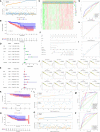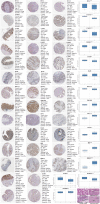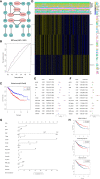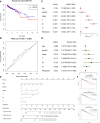The Effects of Autophagy-Related Genes and lncRNAs in Therapy and Prognosis of Colorectal Cancer
- PMID: 33777735
- PMCID: PMC7991845
- DOI: 10.3389/fonc.2021.582040
The Effects of Autophagy-Related Genes and lncRNAs in Therapy and Prognosis of Colorectal Cancer
Abstract
Cellular autophagy plays an important role in the occurrence and development of colorectal cancer (CRC). Whether autophagy-related genes and lncRNAs can be used as ideal markers in CRC is still controversial. The purpose of this study is to identify novel treatment and prognosis markers of CRC. We downloaded transcription and clinical data of CRC from the GEO (GSE40967, GSE12954, GSE17536) and TCGA database, screened for differentially autophagy-related genes (DEAGs) and lncRNAs, constructed prognostic model, and analyzed its relationship with immune infiltration. TCGA and GEO datasets (GSE12954 and GSE17536) were used to validate the effect of the model. Oncomine database and Human Protein Atlas verified the expression of DEAGs. We obtained a total of 151 DEAGs in three verification sets collaboratively. Then we constructed a risk prognostic model through Lasso regression to obtain 15 prognostic DEAGs from the training set and verified the risk prognostic model in three verification sets. The low-risk group survived longer than the high-risk group. Age, gender, pathological stage, and TNM stage were related to the prognostic risk of CRC. On the other hand, BRAF status, RFS event, and tumor location are considered as most significant risk factors of CRC in the training set. Furthermore, we found that the immune score of the low-risk group was higher. The content of CD8 + T cells, active NK cells, macrophages M0, macrophages M1, and active dendritic cells was noted more in the high-risk group. The content of plasma cells, resting memory CD4 + T cells, resting NK cells, resting mast cells, and neutrophil cells was higher in the low-risk group. After all, the Oncomine database and immunohistochemistry verified that the expression level of most key autophagy-related genes was consistent with the results that we found. In addition, we obtained six lncRNAs co-expressed with DEAGs from the training set and found that the survival time was longer in the low-risk group. This finding was verified in the verification set and showed same trend to the results mentioned above. In the final analysis, these results indicate that autophagy-related genes and lncRNAs can be used as prognostic and therapeutic markers for CRC.
Keywords: autophagy; colorectal cancer; gene; immune; lncRNA; prognosis.
Copyright © 2021 Yang, Feng, Bai, Zhang, Zhou, Liao, Lei, Zhang, Huang and Li.
Conflict of interest statement
The authors declare that the research was conducted in the absence of any commercial or financial relationships that could be construed as a potential conflict of interest.
Figures








Similar articles
-
The Role of Autophagy in Tumor Immune Infiltration in Colorectal Cancer.Anal Cell Pathol (Amst). 2022 Mar 14;2022:2055676. doi: 10.1155/2022/2055676. eCollection 2022. Anal Cell Pathol (Amst). 2022. PMID: 35321516 Free PMC article.
-
Comprehensive analysis of EMT-related genes and lncRNAs in the prognosis, immunity, and drug treatment of colorectal cancer.J Transl Med. 2021 Sep 15;19(1):391. doi: 10.1186/s12967-021-03065-0. J Transl Med. 2021. PMID: 34526059 Free PMC article.
-
Construction of a prognostic model of colon cancer patients based on metabolism-related lncRNAs.Front Oncol. 2022 Sep 29;12:944476. doi: 10.3389/fonc.2022.944476. eCollection 2022. Front Oncol. 2022. PMID: 36248984 Free PMC article.
-
A Prognostic Model Based on the Immune-Related lncRNAs in Colorectal Cancer.Front Genet. 2021 Apr 20;12:658736. doi: 10.3389/fgene.2021.658736. eCollection 2021. Front Genet. 2021. PMID: 33959151 Free PMC article.
-
Identification of MFI2-AS1, a Novel Pivotal lncRNA for Prognosis of Stage III/IV Colorectal Cancer.Dig Dis Sci. 2020 Dec;65(12):3538-3550. doi: 10.1007/s10620-020-06064-1. Epub 2020 Jan 20. Dig Dis Sci. 2020. PMID: 31960204 Review.
Cited by
-
Development and validation of cuproptosis-related lncRNA signatures for prognosis prediction in colorectal cancer.BMC Med Genomics. 2023 Mar 22;16(1):58. doi: 10.1186/s12920-023-01487-x. BMC Med Genomics. 2023. PMID: 36949429 Free PMC article.
-
Experimental prognostic model integrating N6-methyladenosine-related programmed cell death genes in colorectal cancer.iScience. 2023 Dec 13;27(1):108720. doi: 10.1016/j.isci.2023.108720. eCollection 2024 Jan 19. iScience. 2023. PMID: 38299031 Free PMC article.
-
Identification and validation of an inflammation-related lncRNAs signature for improving outcomes of patients in colorectal cancer.Front Genet. 2022 Sep 30;13:955240. doi: 10.3389/fgene.2022.955240. eCollection 2022. Front Genet. 2022. PMID: 36246600 Free PMC article.
-
MALAT1-related signaling pathways in colorectal cancer.Cancer Cell Int. 2022 Mar 19;22(1):126. doi: 10.1186/s12935-022-02540-y. Cancer Cell Int. 2022. PMID: 35305641 Free PMC article. Review.
-
Identification of Autophagy-Related LncRNA to Predict the Prognosis of Colorectal Cancer.Front Genet. 2022 Aug 11;13:906900. doi: 10.3389/fgene.2022.906900. eCollection 2022. Front Genet. 2022. PMID: 36035142 Free PMC article.
References
LinkOut - more resources
Full Text Sources
Other Literature Sources
Research Materials

